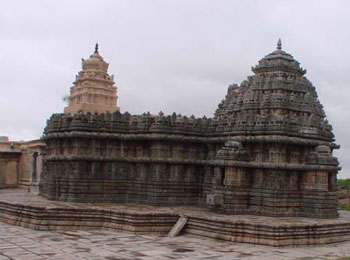- Vishnu
Laxmi Narasimma Temple
- Nuggehalli,Karnataka
- View on map
- Tell us about this temple
Overview
The Laxmi Narasimma temple was built in 1246 CE by Bommanna Dandanayaka, a commander in the Hoysala Empire during the rule of King Vira Someshwara. It is a good example of 13th century Hoysala architecture. Located a short distance away in Nuggehalli, and built around the same time is the Sadashiva temple. The town was called Vijaya Somanathapura in ancient times and gained importance as a place of learning during the time of Bommanna Dandanayaka. Nuggehalli, (also spelled "Nuggihalli"), is a town in Hassan district of Karnataka, India. It is located on the Tiptur-Channarayapatna state highway and is about 50 km from Hassan city. It is well connected by road with Bangalore, the state capital.
About the deity
The idol of Laxmi Narasimma temple is made of intricately carved stone.
About The Temple
The temple was built in the year 1911. It is a beautifully decorated Hoysala temple. It has three towers and the vimana which has intricately carved wall sculptures. Soapstone is the material that was used for building the temple.
Lord Narasimma is an avatar of Lord Krishna. As per Hindu scriptures, Upanishads and Puranas, Vishnu took the form of Narasimma for destroying the demon. Narasimma is visualised as half lion and half man. The upper is in the form of a lion with claws. The lower is human form. The Laxmi Narasimma temple has Lord Narasimma with Goddess Laxmi who is the wife of Lord Vishnu.
Legend and Stories
The art and architecture of the Laxmi Narasimma temple boasts of the Hoysala culture and tradition. The idol of Laxmi Narasimma temple is made of intricately carved stone. This temple was built by Bommanna Dandanayaka, a commander in the court of King Vira Someshwara during 1246 AD. One gets to see lathe turned pillars at the Laxmi Narasimma temple and at most of the temples built during the Hoyasala rule.
The tower of the temple has been built in typical North Indian style. There is a very big hall with attractive sculptures. There are a number of sculpted deities on the pillars and there are close to 120 sculpted panels. One can see exclusive Hoysala style sculptures on the friezes. These include men and soldiers riding elephants and horses, processions with elephants and so on which are finely sculpted. Stories from Ramayana and Mahabharata are also beautifully depicted on the pillars.
The carvings depict Western Chalukya era and is made of green schist or soapstone. The Hoysala kings encouraged this form of architecture. The main shrine has five projections on every side. There are three smaller roofs which have rich architecture and are decorated beautifully.
One can see three different layers of paintings. At the base there is a procession of elephants, horsemen and foliage. The second section has stories from the puranas and Hindu epics. The topmost frieze depicts imaginary beasts or makaras along with swans. Since it is a Vaishnava temple, one gets to view images of Keshava, Venugopala and Laxmi Narasimma (all Vishnu forms).
Accessibility
Airport
The nearest airport to Sri Laxmi Narasimma Temple is Bangalore airport.
Railways
The nearest railway station to Sri Laxmi Narasimma Temple is Bangalore Railway Station.
Road
There are State Road Transport buses that ply between Hassan to Nuggehalli. With increasing visits to this beautiful temple, many private bus operators are also available.
Temple Address
Laxmi Narasimma Temple,
Nuggehalli Main Road,
Hassan 573131,
India
Significance
Devotees visit this temple to seek fulfillment of the following:-
- Fame
- Freedom from diseases
- Wealth
- Courage
- Relief from adverse effects from bad planetary aspects
- Relief from bondage
Shlokas
Achutham Keyshavam Rama Narayanam Krishna Damodaram Vasudevam Harim Shridharam Madhavam Gopika Vallabham Janaki Nayakam Ramachandram Bhajey
Meaning -Oh Lord who cannot be perished, who also has names like Keshava, Rama, Damodara, Narayana, Sridhara, Madhava, Krishna, Ramachandra the beloved of Janaki, let me say your name regularly.
Vasudeva Sutham Devam Kamsa Chanoora Mardhanam Devaki Paramanandham Krishnam Vande Jagathgurum
Meaning -I bow to you O Krishna, the ultimate guru, Devaki and Vasudeva's son, and the destroyer of Kamsa and Chanur.
Adharam Madhuram Vadanam Madhuram Nayanam Madhuram Hasitam Madhuram Hridayam Madhuram Gamanam Madhuram Mathuraa Dhipate Rakhilam Madhuram
Meaning -Meaning - Sweet are Your lips, sweet is Your face, sweet are Your eyes, sweet is Your smile, sweet is Your heart, sweet is Your gait, O Lord of Mathura, everything about You is sweet.
Alokya Mathur Mukha Madarena Sthanyam Pibantham Saraseeruhaksham Sachinmayam Devam Anantha Roopam Balam Mukundam Manasa Smarami
Meaning -I think of this Balamukundan as the one who looks lovingly at his mother's face while taking milk from her, who has eyes similar to the red lotus, who is the embodiment of truth and intelligence and other forms.
